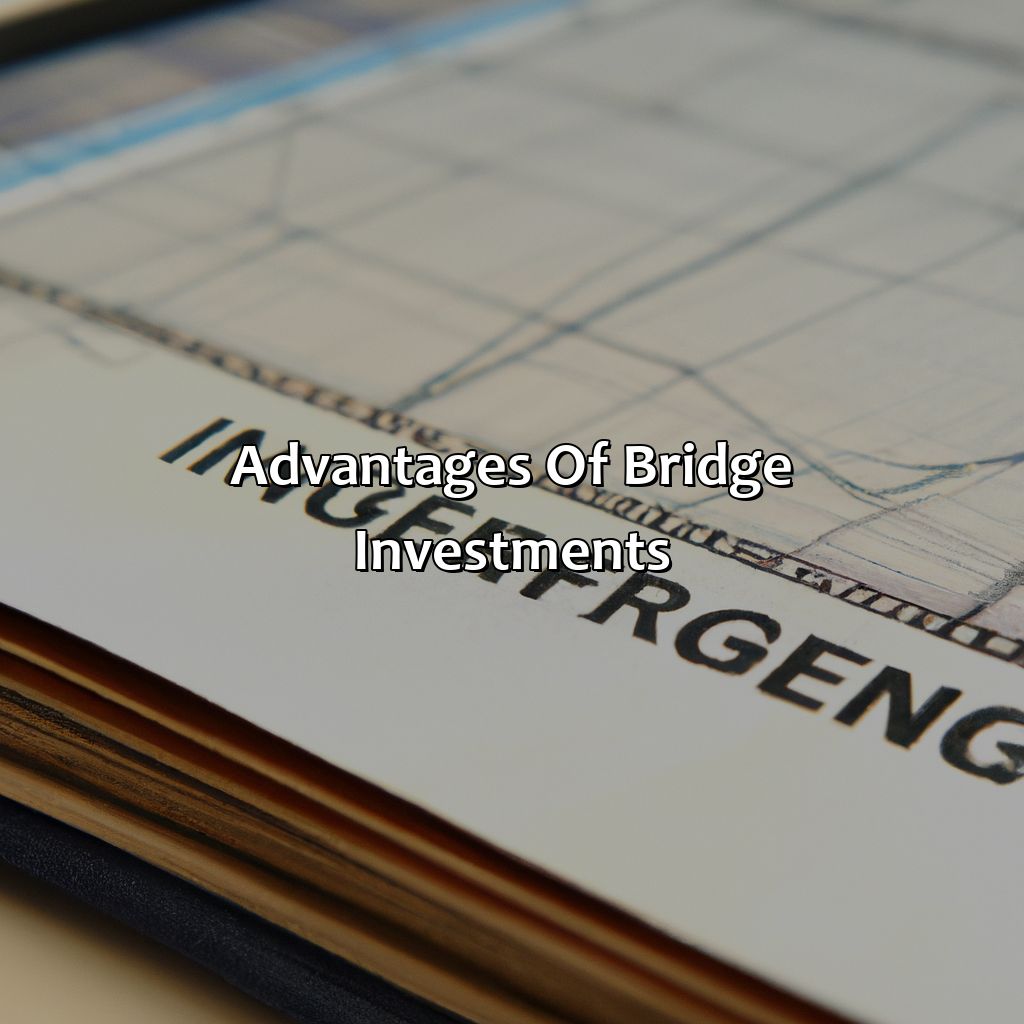What Is A Bridge Investment?
Key Takeaway:
- Bridge investment is a short-term investment strategy that provides immediate financing to bridge the gap between two financial transactions.
- Bridge investments are highly flexible in terms of repayment, have a short-term duration, and offer the potential for high returns.
- There are two types of bridge investments: property bridge loans and business bridge loans. Conducting due diligence, identifying a reliable lender, and assessing risks and returns are essential steps for investing in bridge investments.
Have you ever thought of a way to bridge the gap between your current wealth and financial security? Bridge investments could be the answer! By providing short-term liquidity, they can help you meet the needs of today without sacrificing your financial future. Discover how bridge investments can help you reach your goals.
What is a Bridge Investment?
Bridge Investment – Understanding this Transitory Investment Tool
Bridge investment is a short-term financing solution, typically used to bridge gaps in funding for projects such as property acquisition or development. This type of investment is commonly secured by the underlying asset, ensuring relatively low risks for investors.
Bridge investment provides a means to quickly secure funds and finish projects within a limited time frame. This temporary solution enables investors to benefit from high returns on their investment, over a relatively short period.
Bridge investment vehicles are regularly utilized across various industries, including real estate, infrastructure, and technology. They provide significant returns for investors, while also facilitating progress towards the end goal.
In addition to frequent utilization across different industries, bridge investments are gaining traction among small business owners, who aim to finance projects like expansion or upgrades.
An example of bridge investment in practice is a developer purchasing an old office building, financing the purchase through bridge financing at a relatively high-interest rate. This developer then renovates the building and increases its value, allowing them to sell the asset promptly, repaying the bridge loan and earning a substantial profit.
Overall, bridge investment proves to be a promising tool to limit financing gaps and enable successful project completion.

Image credits: retiregenz.com by James Jones
Definition of Bridge Investment
Bridge Investment – A Comprehensive Understanding
Bridge Investment refers to a type of short-term funding utilized by businesses to solve an immediate financial problem. This type of investment is generally used as a stop-gap arrangement before more permanent financing can be secured.
Bridge financing is often used to bridge the gap between the purchase of a new asset, such as a property, and the sale of an existing one. Such a type of funding is particularly useful when a company needs capital quickly. In such cases, the company may not have enough time to go through the entire loan process, or it may not be eligible for traditional lending options. Bridge financing can help businesses take advantage of opportunities that would otherwise have been missed.
In addition to providing quick access to funding, bridge financing can also help businesses improve their credit scores and increase their borrowing limitations. Moreover, this type of investment is usually secured against the asset being purchased, making it less risky for lenders.

Image credits: retiregenz.com by David Arnold
Advantages of Bridge Investments
Gain insight into the perks of bridge investments! These include: flexibility, short-term duration, and high returns. Keep reading to learn more about the key benefits of bridge investments.

Image credits: retiregenz.com by Harry Jones
Flexibility in Terms of Repayment
When it comes to a bridge investment, borrowers receive the advantage of having flexibility in their terms of repayment. This means that they have the option to structure their repayments in a way that is more favorable for their financial situation. This flexibility allows them to make payments on an as-needed basis, rather than adhering to strict payment schedules that could be detrimental to their finances.
Furthermore, this also means that if borrowers experience any unforeseen financial issues that may prevent them from making payments, they have a certain leeway to make adjustments to their repayment plans. This makes bridge investments much more accessible and attractive for individuals who may be facing financial uncertainty or are looking for short-term solutions.
It is worth noting that although there is some flexibility in repayment terms, it’s always important for borrowers to fulfill their obligation of repaying the loan. The team behind the bridge investment will make sure borrowers uphold their end of the deal while providing clear communication about any needed changes along the way.
In true history, many successful real estate projects were financed by bridge investments because it enabled builders and investors to quickly secure funds without getting held up by lengthy approval processes often associated with traditional lending institutions.
Bridge investments are like the Tinder of the financial world – short-term flings that can lead to long-term gains.
Short-Term Duration
Bridge investments, which typically last for a brief period of time, present numerous advantages. With a short-term duration, these investments provide greater flexibility and the opportunity to capitalize on profits quickly. Additionally, as bridge loans are secured by collateral such as property or inventory, investors can make confident decisions with less risk.
Moreover, bridge investments also offer an opportunity for investors to diversify their portfolio and earn high returns on investment in a short amount of time. This allows investors to have more control over their finances and grow their wealth with greater efficiency.
A notable example of this can be seen in the real estate industry where bridge lenders play a crucial role in helping property developers obtain financing for major projects. By offering temporary funding in exchange for collateral, these lenders help to ensure that construction projects come to fruition and properties are brought to market quickly.
As such, it’s clear that the benefits of bridge investments are many. From flexibility and low risk to diversification and high returns on investment, these types of investments provide an opportunity for savvy investors to grow their wealth while limiting exposure to unnecessary risk.
Get ready to bridge the gap between average returns and high potential returns with bridge investments – it’s like going from a tricycle to a Lamborghini.
High Potential Returns
Investing in bridges can lead to exceptional financial benefits that surpass other investment methods. The potential for significant returns on investment is notably high with bridge investments. These are short-term but lucrative investments that primarily focus on properties in high demand locations. Unlike stocks or bonds, bridge investments offer the potential for higher yields in a shorter period.
The high potential returns of bridge investments are attributed to numerous factors, such as quick accessibility, less red tape, and lower capital requirement than typical real estate investment opportunities. Bridge loans offer immediate funds for individuals looking to make down payments on their commercial property ventures and can significantly lower their risks. Furthermore, there are minimal waiting periods for loan approval and disbursement of funds related to bridge financing.
An essential element of successful bridge investing is the ability to identify market trends accurately and unique opportunities before they become widespread knowledge. For instance, buying a property below market value or discovering an upcoming infrastructure plan from the government that will significantly impact property values can lead to enormous profits.
Many investors have experienced profitable returns from investing in bridges across various geographies worldwide, making it clear that this approach has great growth potential globally. An example comes from Los Angeles where investors made significant gains by investing in a young company’s expansion through a bridge loan agreement.
In summary, bridge investing stands among the most reliable short-term investments with remarkable profit potential when done correctly. By understanding the market trends and finding suitable lending options, an investor can benefit from substantial one-time profits while minimizing risks involved in long-term real estate investments.
Bridge investments come in all shapes and sizes, kind of like a box of chocolates, but with less risk of cavities.
Types of Bridge Investments
Gaining insights on the different bridge investments? Check out the “Types of Bridge Investments” section! It provides you with the solutions for things like property bridge loans and business bridge loans. Thus, you can make wiser decisions on your investment strategies.

Image credits: retiregenz.com by James Washington
Property Bridge Loans
A bridge investment in the property sector is a short-term financing option used to purchase, renovate, or develop real estate before securing long-term financing. These loans are risky for lenders but offer high returns for investors. They provide funds to bridge the gap between the purchase price and long-term funding or sale of the property.
Property bridge loans have higher interest rates due to their short maturities and riskier profiles. Borrowers need to provide collateral, such as property, to secure these loans. The loan amount is based on the value of the asset, loan-to-value ratio, and borrower’s creditworthiness. Property bridge loans come with different terms and conditions including prepayment penalties, extension fees, and other costs.
Furthermore, borrowers need to have an exit strategy before applying for a bridge loan. The exit strategy could be selling the property, paying off the loan with long-term financing or refinancing it into a permanent mortgage. Additionally, lenders may require detailed renovation plans and project timelines.
True Story: A real estate developer needed immediate funding to secure a prime commercial property before his competition did. After applying for numerous loans without success, he finally secured a property bridge loan that allowed him to compete with larger firms that had access to conventional financing options. He was able to renovate the property within six months and sell it at a profit that exceeded his expectations thanks to the timely funding he received from his bridge loan provider.
Get ready to be bridged to success with Business Bridge Loans – just don’t forget your safety net!
Business Bridge Loans
When a company requires short-term funds to support their cash flow and operations, they can turn to Commercial Bridge Financing. This type of financing serves as a ‘bridge’ between the current state of the business and its future financial goals. Such loans have a shorter term than traditional loans – usually less than two years. The lender considers factors like collateral, credit history, market conditions, and the borrower’s ability to repay before approving the loan.
Commercial bridge financing is an ideal solution for businesses that need quick access to funds for growth, expansion, or other urgent needs like manufacturing delays or repairs after natural disasters. Compared to traditional banks, commercial bridge lenders require fewer documents and have a faster processing time.
Commercial bridge loans are also not limited to just established businesses. New startups can also qualify if they have sufficient assets or personal guarantees against the loan amount.
As an example of how a commercial bridge loan works in practice, consider a small restaurant chain that wants to expand but has insufficient cash reserves and doesn’t qualify for traditional bank financing. By securing a commercial bridge loan, they can fund the renovations without disrupting their daily operations. Once completed, the renovated locations drive additional revenues that satisfy the loan terms with ease – often in under two years!
Investing in bridge investments is like crossing a shaky bridge – nerve-wracking, but potentially rewarding if you make it to the other side.
How to Invest in Bridge Investments
Investing in bridge investments? Do your due diligence! Find a trustworthy lender and evaluate both risks and returns. Knowing the nuances of this type of investing can help minimize losses. Maximize your returns!

Image credits: retiregenz.com by David Arnold
Conduct Due Diligence
Thoroughly Investigate Before Investing
Before investing in bridge investments, it is crucial to conduct thorough due diligence. This involves analyzing the underlying assets, the borrower’s creditworthiness, the loan structure, and any potential risks associated with the investment.
Careful examination should be performed on any previous legal disputes or issues that could impact the investment. In addition, reviewing past performance and projecting future returns is also essential.
Unique Details
To ensure a comprehensive understanding of the investment opportunity, examining market trends and consulting experts can provide valuable insight. Additionally, it may be beneficial to analyze competing investments to determine if this is the best option for your portfolio.
Call-to-Action
Don’t miss out on potential opportunities by neglecting to perform due diligence before investing in bridge investments. Thorough research will increase your chances of making successful investments.
Finding a trustworthy bridge lender is like trying to find a needle in a haystack, except the needle is made of gold and the haystack is made of quicksand.
Identify a Reliable Lender
Evaluating a dependable financier for bridge financing requires comprehensive research and analysis of the lender’s loan history. Look for a reputable lender, with sufficient experience in the industry and a track record of meeting customer expectations. Identify the one who can provide reasonable rates and flexible payment terms that align with your investment objectives.
Consider various lender factors such as underwriting guidelines, prepayment penalties, fees, closing process, speed of funding, and bridge loan schedule to ensure that you receive the best deal possible.
Be sure to scrutinize the company’s background before making an informed choice. Ascertain if they have years of experience in providing bridge loans while upholding unparalleled professionalism and service quality.
A trusted lender is crucial in bridge financing success. For instance, investors can lose their assets or investments from working with unscrupulous or inexperienced financiers. Therefore, do exhaustive due diligence to ensure that you partner with an ethical lending firm that adheres to all agreements’ terms without taking advantage of unsuspecting investors.
Remember, the higher the risk, the higher the returns – but also the higher the chance of being stuck under a bridge.
Assess Risks and Returns
To evaluate the potential of bridge investments, it is crucial to gauge the risks and returns involved. Analyzing current market conditions, loan-to-value ratios, borrower reputation and property valuations can assist in determining possible profit margins.
Bridge investments are exposed to different types of risk factors that need careful evaluation. Investments may be affected by global financial markets or credit risk if borrowers fail to meet their obligations on time. Delineating these risks helps an investor to assess whether the returns outweigh the potential downsides.
Investors should also take into account external conditions and monitor any sudden changes in relevant parameters that could affect their bridge investment. These can include regulatory laws, zoning regulations and shifts in industry practices. Ultimately, updated information on risk and return profiles is critical for effective investment decisions.
Bridge investments have a diverse history with numerous success stories across different industries like real estate and infrastructure funding. One example includes Singapore’s Mandai Park Holdings’ bridge investment used to establish new wildlife parks – which upon completion showed a 20% boost in visitorship numbers in two years following completion. Such anecdotes provide useful illustrations of past results when assessing the suitability of future bridge investments.
Five Facts About Bridge Investments:
- ✅ A bridge investment is a short-term loan used to finance an immediate need. (Source: Forbes)
- ✅ Bridge loans are typically secured by collateral, such as real estate or inventory. (Source: Investopedia)
- ✅ Bridge investments are often used in the real estate industry to finance property purchases or renovations. (Source: The Balance)
- ✅ The interest rates on bridge investments are typically higher than traditional loans due to the short-term and high-risk nature of the investment. (Source: LoanPad)
- ✅ Bridge investments can be a useful tool for businesses and individuals in need of quick financing, but should be approached with caution and proper research. (Source: Entrepreneur)
FAQs about What Is A Bridge Investment?
What is a bridge investment?
Answer: A bridge investment is a short-term funding that is designed to help individuals or companies meet their financial obligations until a long-term financial goal is achieved, such as securing a permanent loan.
What types of businesses are most likely to use bridge investments?
Answer: Bridge investments are commonly used by businesses that need capital quickly, such as startups, real estate developers, and small businesses looking to expand their operations.
What are the benefits of using a bridge investment?
Answer: Some of the benefits of using a bridge investment include quick access to capital, flexibility in terms of repayment, and the ability to secure long-term financing.
What are the risks associated with bridge investments?
Answer: The risks associated with bridge investments include higher interest rates, short repayment terms, and the potential for default if the borrower is unable to secure long-term financing.
How does a bridge investment differ from a traditional loan?
Answer: A bridge investment is a short-term funding solution that is designed for a specific purpose, whereas a traditional loan may have a longer repayment term and may be used for a broader range of purposes.
Who are some of the top providers of bridge investments?
Answer: Some of the top providers of bridge investments include private equity firms, venture capital firms, and specialized lenders that cater to real estate developers and other businesses in need of short-term funding.
